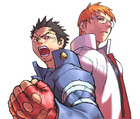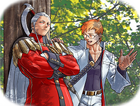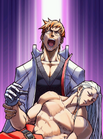Kyosuke Kagami (鑑 恭介 Kagami Kyōsuke) is a fighting game character from the Rival Schools series of 3D fighting games.
Biography
Kyosuke, the "Mysterious Public Man"
Although his last name is Kagami, he is actually the twin brother of the fallen Hyo Imawano.
His personality is the opposite of Batsu's; being cool and calculating, almost never showing emotions of any sort. Every pose he takes stands out with his coolness, and he has a habit of adjusting his eyeglasses whenever he poses. He never shows it, but he really has a strong sense of justice.
Appearance
Kyosuke has short orange hair, brown eyes and he wears eyeglasses. His primary outfit is a white school jacket under a black long sleeve v-neck shirt with a Taiyo emblem on both on his white collar, white pants and white, black and yellow shoes. The interior of his jacket is red.
Story
Rival Schools: United By Fate
Kyosuke is a student of Taiyo Gakuen who volunteers to help Batsu find his mother. It is later revealed that Kyosuke is behind the kidnapping and was working for his twin brother, Hyo Imawano. Ultimately, Kyosuke changes allegiances, and helps Batsu and Hinata in defeating Hyo, while convincing Hyo that force was not the way to achieve their dreams.
Project Justice
In Project Justice, Kyosuke becomes concerned when he meets Kurow and senses the power helping him. When Hyo is later possesed by the spirit of the brothers' father, Kyosuke reluctantly fights his brother again. After the apparent death of Hyo, Kyosuke disappears, with his friends at Taiyo High waiting for him to return to school. Kyosuke had seen his friends from school and went to see Justice High teachers Kyoko and Hideo for reasons unknown.
Arsenal, combat style, and fighting strategy
With lightning-fast uppercuts and fast combo starters, Kysosuke can handle just about any match-up. The key to winning with Kyosuke is to abuse his Light Punch Cross Cutter. At about three to five character widths away from an opponent, Kyosuke can annoy his foe all day long. If the player manages to get the Cross Cutter projectiles to hit consecutively, they can immediately dash in and begin a Textbook Combo with a jab.
Two of his Burning Vigor attacks can be used in indirect sequence. Kyosuke can launch his opponent high into the air with a Super Raijin Upper, perform an Air Combo, and finish the Air Combo with a Double Mirage Kick.
Kyosuke's Team-Up Technique is yet another of his moves. Because it initiates so quickly, the player can do it just about any time the opponent throws out a Burning Vigor attack or even a slow-executing normal move. The attack is actually the second weakest Team-Up technique in the game.
Most players using Kyosuke in Project Justice utilize a glitch that makes Kyosuke levitate--considered by many to be a cheap tactic.
Special Attacks
- Cross Cutter (クロスカッター) - Kyosuke fires two converging crescent-shaped projectiles. Hits twice at close range, but only once at the point where the two projectiles converge. Evading this move by jumping is difficult; sidestepping it is a simpler way.
- Mirage Kick (幻影キック Gen'ei Kick) - Closely similar to his twin brother's Phantasm Kick. The only difference is that Hyo's attack is a slash; Kyosuke's is a kick. Like the Phantasm Kick, this has poor recovery time if blocked. While landing to the ground as a result of recovery, he is completely vulnerable to several downward-aimed attacks, ranging from projectile/blast to diving kick attacks. This attack is also usable in the air, but is less damaging if done in the air.
- Mirage Wave (幻影ウエーブ Gen'ei Wave) - An air-only attack. Kyosuke does a Cross Cutter-like attack, only with shorter range. The player can quickly follow with a Mirage Kick for good measure.
- Raijin Upper (雷神アッパー Lightning God Upper) - A bolt of lightning rises from the ground, launching the opponent into the air. It has considerable recovery delay if blocked.
- Mirage Breaker (幻影ブレーカー Gen'ei Breaker) - Kyosuke does an overhead leaping punch that stuns the opponent in sparks. Even if blocked, Kyosuke will be able to attack even before the opponent can, since this attack has no recovery delay whatsoever.
- Aerial Float (空中浮き Kuuchuu Uki) - This is the well-known game bug utilized by many players in Project Justice. While in the air, the button combination is input, making Kyosuke stay airborne. He is invulnerable to almost all sorts of attacks while airborne, and all the attacks he delivers are at ground-level, despite his altitude. He can even execute Team-Up and Party-Up attacks while airborne. The only tactic that can foil this is a throw maneuver.
Burning Vigor Attacks
- Diffusion Cross Cutter (拡散クロスカッター Kakusan Cross Cutter) - The powered version of the Cross Cutter, wherein Kyosuke fires five converging projectiles. Contrary to the Cross Cutter, this is best done from a distance, where this attack deals more hits and (very obviously) more damage. The downside to this attack is its long recovery delay.
- Double Mirage Kick (ダブル幻影キック Double Gen'ei Kick) - Actually, he does more than just two Mirage Kicks, since a four-hit Mirage Wave follows. This is also usable in the air, and makes a good Air Combo finisher. As with the Mirage Wave, a Mirage Kick can be executed immediately afterwards for an extra hit.
- Super Raijin Upper (スーパー雷神アッパー Super Lightning God Upper) - Powered version of the Raijin Upper, wherein this move launches the opponent high into the air. Startup is fast, and is an excellent Tardy Counter. It can even completely foil dash-type Burning Vigor attacks from the opponent if this is done as a well-timed counterattack.
Team-Up Technique
- Last Symphony (ラストシンフォニー) - Kyosuke and the active character execute a fast barrage of blows to the opponent.
Party-Up Technique
- Kyosuke does the Final Symphony.
Other appearances
Outside of the Rival Schools games, Kyosuke also is a playable character in Capcom vs. SNK 2. One of his super moves in that game includes cameos by Batsu and Hinata.
Cameos
Kyosuke made a small cameo appearance in UDON's Street Fighter Legends: Sakura comic.
Kyosuke also appeared as a card in the Heroes and Heralds mode of Ultimate Marvel vs. Capcom 3.
Trivia
- Given the fact that Hyo is his twin brother and Raizo is their uncle, it means that the twins are actually cousins of Batsu.
- He lives alone in a mansion near an unnamed college campus.
- Academically, he excels in math and science, and apparently has no subject where he fares poorly in.
- As of Project Justice, he is the Chairperson of the school's morals committee.
- Kyosuke actually knows how to play the saxophone, as indicated in the ending photo of the board game of the Japanese version of Project Justice.
- His officially-credited last name, Kagami, can also be written as the Kanji character 鏡 (also read kagami on its own) which means 'mirror'. If seen as so, it makes sense why Kyosuke spends a lot of time looking in the mirror every day.
- He is voiced by Isshin Chiba.
Gallery
Sprites
References
Game and Character Information
Nguyen, John. Project Justice FAQ/Move List by Puar. GameFAQs.com. Published 2001. Last accessed 14 March 2010.
Tsai, Peter. FAQ/Movelist for Project Justice (Moero! Justice Gakuen) for Dreamcast/Arcade. Version 1.07. GameFAQs.com. Published 17 July 2002; last updated 13 March 2003. Last accessed 14 March 2010.
Cheshire, Sophie. Project Justice: FAQ/Move List by falsehead. Final version. GameFAQs.com. Published 5 November 2001; final update 7 December 2002. Last accessed 14 March 2010.
Batsu, the Doctor of Punishment. Shiritsu Justice Gakuen/Rival Schools series: Character Stories FAQ. Version 1.5 (final). GameFAQs.com. Last accessed 14 March 2010.
NeoChaosX. List of characters in the Rival Schools series. Wikipedia (English). Created 20 August 2007; last updated 30 March 2010. Last accessed 1 April 2010.
Translations
Kanji translations made possible through the Kanji Romaji Hiragana Convert website.
Maruyama, Chiemi. English-Kanji-Japanese/Japanese-Kanji-English Dictionary. Pasig City, Philippines: Persian Gulf Publication, 2002. ISBN 978-971-8796-37.
Nakao, Seigo. Random House Japanese-English/English-Japanese Dictionary. United States: Ballantine Books, 1995. ISBN 0-345-40548-X.















